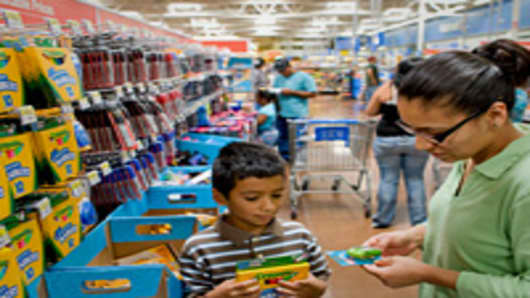It’s that time of year again when pint-size customers and their families scour stores in search of that perfect first-day outfit and the hottest school supplies at prices that won’t burn a hole through parents’ wallets.
This season, shoppers are ready to hit the racks again, and nearly nine in 10 plan to spend the same or more on back-to-school shopping, according to a survey from Deloitte released Tuesday.
The survey, commissioned by the consulting group, was conducted by an independent research company between July 5 and July 12. The survey polled 1,134 parents of children in grades K-12.
“What really stood out to me is I think I had an expectation that consumers would be a little more glum than they turned out to be,” said Alison Paul, vice chairwoman at Deloitte and the retail and distribution sector leader.
Deloitte's poll follows a similarly upbeat survey from The National Retail Federation that indicates that the average person with children in school will shell out about $688, a 14-percent increase from last year.
This is welcome news for companies that have already launched aggressive promotions to snag customers during what is traditionally the second-busiest time for retailers, after the Christmas season.
Still, consumers have not forgotten about the sputtering economy. Nearly half of respondents in the Deloitte survey think the economy remains in a recession (explain this), and a majority listed higher food and energy prices among the top concerns that could impact their back-to-school shopping.
A majority of respondents this year attributed their plans to ratchet up their spending to prices that are generally higher. About a third cited more expensive items, such as computers, on their children's shopping lists as a reason for spending more.
In an encouraging sign for retailers, the percent of respondents who plan to spend less than $100 plummeted by half this year to 9 percent, while the proportion who expect to spend at least $500 rose to 27 percent.
“There’s a real bifurcation among consumers,” Paul said. “There’s a tale of two consumers, if you will.”
Paul added that this is an ongoing trend and that "the folks who are fairly well-heeled are starting to spend more or say they will."
Among those who made six digits or more, 88 percent said their financial situation had improved or stayed the same compared to this time last year, while only 69 percent of their lower-income peers held the same optimistic view.
Consumers’ optimism has translated into decreased interest in dollar stores and off-price stores from the height of the recession.
“I think a couple years ago — what we saw in the data was that dollar stores were the number two choice for consumers behind discount (department) stores,” she said. “What that said to us was price was all important. It was really the only criterion that people were worried about.”
Now, consumers increasingly said they will turn to office supply stores, traditional department stores and specialty clothing stores in their search for variety and products with additional features and functions.
Paul said the recession caught many office supply stores “flat-footed,” which enabled dollar stores to scoop up their sales. In response, office supply retailers have ramped up their marketing and sales to lure customers.
This year, Staplesis promoting paper clips and folders for a penny with a $5 minimum purchase, and Office Depotis selling packs of pens for a quarter.
The survey also examined how consumers plan to use technology while checking off their summer shopping checklists. Nearly two-thirds of smartphone owners say they will use their smartphones to help them shop this season.
Among this group, a quarter plan to shop online while almost half said they would download discounts, coupons or sale information using their mobile devices. Meanwhile, about 15 percent of respondents plan to use social networking sites to find out about store promotions.
The report also hinted at a potential new customer for retailers: little Timmy (or Susie) himself. Nearly two in five respondents indicated that their children planned to spend $201 or more of their own money on items for school, a two-fold increase over last year.
The National Retail Federation's survey provides further evidence of these high rollers in training. The federation found that kids ages 6 to 12 plan to spend 70 percent more than last year.
Questions? Comments? Email us at consumernation@cnbc.com. Follow Katie Little on Twitter @katie_little.



